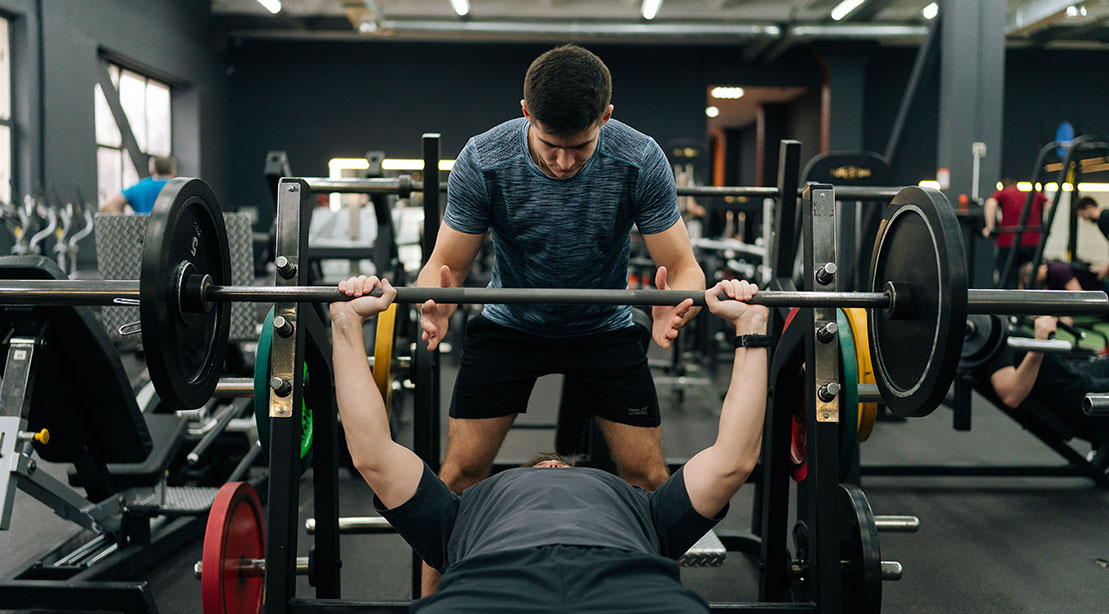28-Days-to-Lean Meal Plan
With the right plan and the right discipline, you can get seriously shredded in just 28 days.
Read article
Walk into your commercial gym on a Monday afternoon, and you’ll be taking part in International Bench Press day without even knowing it. The line for the bench stations go out the door and down the street. So expect to find yourself patiently waiting to get a pump. It’s bad enough that most of these guys should train legs instead—but it gets worse. The overwhelming majority of lifters don’t even know how to bench the right way. That’s where this bench press tips guide will help you lift more while avoiding potential injuries.
For men, it’s often about the ego. For decades, the universal question of strength has been “What do you bench press?” It’s the most glamorized exercise in the gym. You can call it the 100-meter dash of weight training. Pushing the most weight equals the most bragging rights, and whatever form and technique it takes to get there is fair game.
Then the reigning king gets a shoulder injury and his throne is usurped by another half-repper.
For an average person looking to train for health and proper muscle balance, the bench press is not as important as other lifts. But truth is truth: People want to get bigger and stronger – and training the bench to jack up the pecs and improve upper body pressing strength can come in handy. Here’s a bench press tips guide to make sure you’re moving the most weight you can, properly.
The first thing many novice lifters default to is a wider grip. Not only does it allow for the outer chest (attachment points) to get slightly more stimulated, but it also can shorten the bar’s range of motion, making it possible to move more weight.
Though the above may be true, it could happen at the expense of your shoulders. Lifters who have longer arms or who are just taller in general don’t always fare well with this cue. Unwanted shoulder stress can wreak havoc on a strong bench press. It’s important make sure that your hand position lines up with the geometry of your body and the physics of the movement.
Oftentimes, a lifter will use a wider grip with flared elbows, and lower the bar to the same spot on the torso that he would when using a narrower grip. This is one of the biggest rookie mistakes in the game. As a general rule of thumb, a narrowed grip should equal a placement lower on the torso (toward the navel) and a wider grip should equal a placement higher up on the torso (towards the face). Following this guide will ensure that the elbows and forearms correspond and position themselves vertically under the bar for the best force production you can apply.
The bench press is an exercise that requires plenty of stability for it to be strong. Given its demands on the shoulder capsule, the scapulae and the muscles that attach to it are the ones that need the most attention. Decent form and just training the bench often can get you somewhere. Eventually, though you plateau over time—because something’s gotta give. The hidden truth comes in training the upper back.
You’ll be hard pressed to find a 400-plus bencher with a pair of chicken wing shoulder blades. Use horizontal pulling exercises like seated rows, inverted rows, reverse flyes, one arm dumbbell rows and bentover rows to improve the strength of the shoulder retractors and external rotators like the rhomboids, rotator cuff muscles and rear deltoids. Even the upper traps can act as huge stabilizers to the bench press for intermediate lifters. The message is simple. The stronger you get at pulling, the stronger you’ll be at pushing. Don’t believe this bench press tips? Try it.
Sounds silly, right? Well the truth of the matter is that it’s one of the most commonly botched movements in the gym. From half-reppers to those who pick their feet off of the ground to prevent “cheating,” the bench press definitely has the most diverse group of form fails I’ve ever seen.
The truth is, the bench press is one of the most technical lifts out there. It actually allows for more margin for error than your standard biceps curl or row. The common fluffy cues like “your entire back should be flat against the bench,” and “knees at 90 degrees” should be sent to the crypt immediately. You need to get into the right position to get the back muscles tight and involved in supporting the shoulder, and to bear the most load. Check out the video below for a thorough bench press rundown.
Remember this: You’ve got bigger fish to fry than worrying too much about a bigger bench. So take these cues and tips with an open mind, and only for what they’re worth. In my eyes, having a bigger squat, deadlift, and overhead press will give you more bang for your buck as a strong human being. Also, if size is your primary focus, there are other chest exercises that can take you far. For example, give the dumbbell incline press a try.
With that said, use these bench press tips to give your best when you decide to use the exercise. Don’t be a Monday zealot – much less a Monday zealot with bad form and a weak lift.